TSBC-SW:Cloud:VmWare Installation
Contents |
Requirements
Minimal Cloud requirements:
- Vmware ESX 5 or 6
- 64 bits infrastructures only
- 4 vCPU
- 20G hard drive
- 8G RAM
- E1000 NIC emulation or VMXNET3 interfaces
- One Ethernet adapter for management
- One or more Ethernet adapter(s) for data
For better performance (see optimization section)
- CPU resource: allocation shares set to 'high'
- CPU resource: reservation set to maximum and no limit (i.e. 'unlimited')
- Memory resource: reserve all guest memory (all locked)
- Disk: shares 'high'
- Advanced CPU: Hyperthread core sharing to 'None'
Getting the Image
Please contact our sales team at sales@telcobridges.com to get a copy of the latest TBSC Image.
Installation on VmWare cloud
TBSC VmWare Image
A virtual machine image is a single file that contains a virtual disk that has a bootable operating system installed on it. Images are used to create virtual machine instances within the cloud.
You will need to upload the latest TSBC image into your VmWare before you can launch a virtual machine instance running the TSBC software.
Launching an instance
- Log in using the Vmware infrastructure client interface
- Select File->Deploy OVF Template... from the menu

- Browse to the location of the TSBC-SW image obtained from TelcoBridges
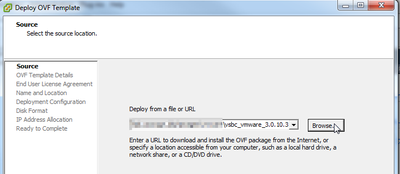
- Click 'Next' until you need to name the new virtual machine instance. Enter the name and click 'Next'
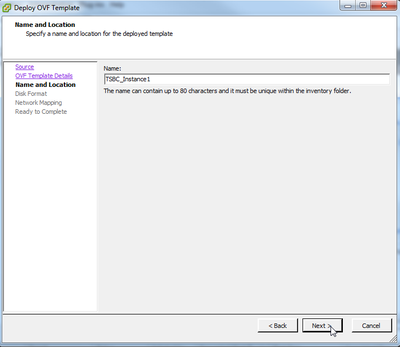
- Select a datastore (if more than one are available) and select "Thick Provision Lazy Zeroed" as the disk format then click 'Next'

- Accept all other default settings and wait until the machine is deployed.

- Once deployed, right-click on the new instance and select "Edit Settings..."
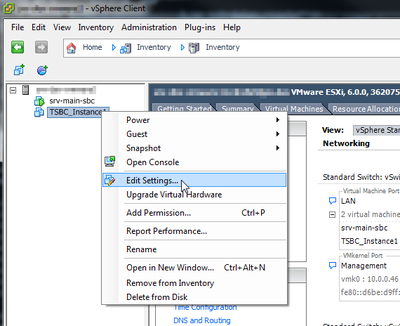
- Edit network adapters to connect on proper networks. Make sure that at least one of the adapter connects to the private management network of the setup from which WebPortal access will be granted. Do not press the 'OK' button yet.
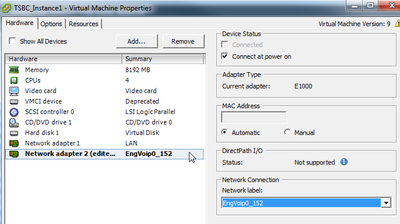
- Go to the 'Resources' tab and select the CPU item. Set 'Shares' to 'high', slide the 'Reservation' cursor to the max (i.e. right) and make sure the 'Unlimited' option is checked-marked. Do not press the 'OK' button yet.
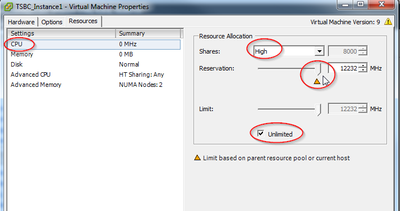
- Select the 'Memory' item and check-mark the 'Reserve all guest memory (All locked)' option. Do not press the 'OK' button yet.
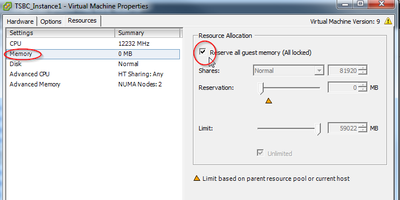
- Select the 'Disk' item and set the 'Shares' to 'High'. Do not press the 'OK' button yet.

- Select the 'Advanced CPU' item and set the 'Mode' to 'None'. Do not press the 'OK' button yet.

- Press the 'OK' button
- Back to the main screen, select the newly instantiated virtual machine, right-click and select "Power-->Power On" to start it.
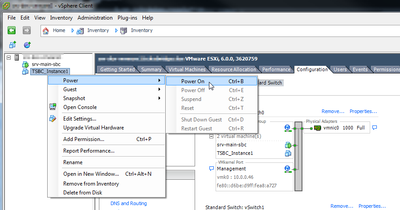
- Again to the main screen, select the newly instantiated virtual machine and choose the 'Summary' tab. Once the virtual machine is completed booted, the assigned DHCP IP address will be displayed by clicking on the 'View all' button. Note this IP address to access the Web Portal configuration interface later.

Accessing the TSBC-SW
Accessing the TSBC-SW web portal
- Open a web browser to the management IP of the TSBC, on port 12358. Example if your server address is 10.0.0.79, the URL would be:
http://10.0.0.79:12358 - You should get to the TSBC Configuration Wizard
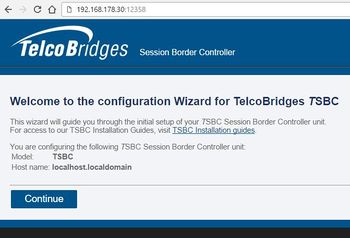
From here, you can go to Web Portal Initial Configuration Guide to continue the installation, and/or optimize your server to get the maximum out of your server.
Web Portal Initial Configuration
Click on the following link to pursue installation from the web portal: TSBC-SW:WebPortal:Initial Configuration
Optimizations
Click on the following link for VmWare optimizations: TSBC-SW:Cloud:VmWare_Optimizations